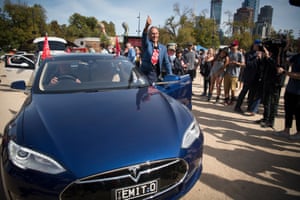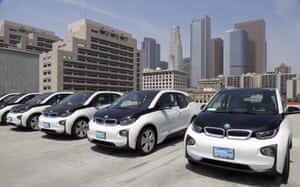As big global carmakers electrify their models, we ask experts about how things could shape up in Australia
Of
all the bizarre sideshows on the 2019 federal election trail, the
pantomime around electric cars had to be one of the strangest. Scott
Morrison argued that Labor’s plan for 50% electric vehicles by 2030
would “ruin the weekend” and the Liberal party paid for Facebook ads
claiming Labor would confiscate tradies’ Hilux utes.
Meanwhile, all the world’s big car manufacturers are busy getting on with electrifying their model ranges. But while things are changing, buying an EV is still a big leap. Guardian Australia spoke to experts about the options.
“Just by critical mass, the cost of the vehicles will moderate but they won’t become cheap,” he says. “And there will be more choice, which will inevitably make the market a bit more competitive.”
"Australians are mindful of CO2, they’re mindful of the cost of running a car"
There are about a dozen models of pure EVs on the market in Australia
from manufacturers including Hyundai, Kia, Nissan, Mitsubishi,
Mercedes-Benz, Renault and Tesla, priced from $46,000 to well over
$100,000. Recharging at superfast charging stations takes less than 30
minutes, or they can be charged overnight at home.Meanwhile, all the world’s big car manufacturers are busy getting on with electrifying their model ranges. But while things are changing, buying an EV is still a big leap. Guardian Australia spoke to experts about the options.
What kind of price tag am I looking at?
The price tag is still the biggest deterrent. Mike Sinclair, the editor of carsales.com.au, says things are improving – there are several models below $50,000, but prices are likely to fall further over the next few years.“Just by critical mass, the cost of the vehicles will moderate but they won’t become cheap,” he says. “And there will be more choice, which will inevitably make the market a bit more competitive.”
"Australians are mindful of CO2, they’re mindful of the cost of running a car"
That’s a big change from a decade ago when, in 2006, the Guardian’s then editor Alan Rusbridger bought an electric car in the UK that resembled something that Noddy would drive through Toyland. It was made mostly of plastic, had a top speed of about 45km/h, a range of 48km, just enough room for two small adults and cost £9,000 ($18,000).
EVs are now fast and luxurious in comparison – they can seat a family comfortably and have ranges measured in hundreds of kilometres. But there are only about 6,000 on Australia’s roads.stralia
Will EVs get cheaper? And when?
In the absence of government policy aimed at boosting uptake (the election campaign demonstrated the Coalition isn’t keen to go down that road), the number of EVs on the road will shift substantially only when they approach price parity – selling for the same price or cheaper than the combustion-engined equivalent.
Bloomberg New Energy Finance is relatively bullish about how long that will take. In 2017, it forecast that the crossover point was in 2026. Its 2019 analysis has this happening in 2022. While its projections are optimistic, the International Energy Agency and oil companies such as BP are predicting this will take place before 2030. A Deloitte report released in January put the tipping point at 2024.

Should I buy now or wait?
This depends largely on personal circumstances and the reality is that more than half of all Australians buy used cars, rather than new, so for them it’s not yet an option.In the next three to five years, there will be a larger range of EVs in the $40,000-$50,000 price bracket with a few under $40,000, Sinclair says, which could be an indication to wait.
But in the meantime, the cost of operating a petrol car could be significant, particularly for high-mileage drivers. And with interest rates at record lows, the cost of financing a new car is lower than it has been for some time.
What about a plug-in hybrid? Is that an option?
Plug-in hybrids work in much the same way as regular hybrids, but they have larger batteries and can be plugged into the wall socket. They’re a compromise between conventional hybrids and battery-only electric vehicles.Gail Broadbent is a PhD student at the University of New South Wales. She researches electric vehicles and owns a plug-in hybrid Mitsubishi Outlander SUV.
Buying an EV is a good option for a family in the market for a second car, but for the primary vehicle it’s worth looking at the option of a hybrid, she says.
“They’ll find most of their driving is running around locally, going to pick up kids, shopping and that’s where an electric car is absolutely ideal because it’s a lot cheaper to run one, it doesn’t have the energy costs, assuming that they plug it in overnight and they have off-peak pricing. If you are looking at two-car families, now is an ideal time to buy.”
But plug-in hybrids, or PHEVs, also come with some widely recognised downsides. There’s the expense and maintenance hassle of both the petrol engine and the electrical systems, and a high upfront cost.
Sinclair says: “The reality is that the technology is expensive. For some of those vehicles it’s almost like putting two powertrains in them – you have a conventional powertrain and you have an electric.”
And plug-in hybrids still consume fuel and produce CO2, which is the reason many people are looking for an alternative in the first place.
What’s the range of electric vehicles? Is it enough?
The Outlander, like many other PHEVs, has a 50km range on the battery, but will automatically switch over to petrol beyond that.
Sinclair and Broadbent are keen to point out that range anxiety – the fear among buyers of running out of charge while driving – will continue to shape the electric vehicle market, despite that fear not actually matching reality.

“The whole issue of range anxiety is a very interesting one,” Sinclair says. “The first crop of electric vehicles will probably have more range than people need but it’s the range that people want.”
Hybrids are not really electric vehicles in the sense of the two other options because all their energy is still taken from fossil fuels, but their widespread adoption shows how quickly something that was once a niche technology can become mainstream in a short time. It’s a glimpse of what EV price parity could look like.
Toyota was the first to bring hybrids to the Australian market with the Prius in 2001 and has sold more than 100,000 since then.
This year, the Japanese carmaker released a hybrid version of its RAV4, which exceeded the company’s sales predictions. Dealers say about three-quarters of customers are now asking for the hybrid version, compared with company estimates of about 40%. That has caused a shortage and the waiting times have blown out to four months despite the vehicle going on sale only a month ago.
Toyota Australia’s vice-president for sales and marketing, Sean Hanley, said that uptake exceeded their expectations.
“We are not surprised that hybrid is growing in the Australian market at all. What we might be a little surprised at is the weight of the sales mix is a lot higher than we anticipated. It’s a good thing.
“Our order intake suggests that over 60% of our future sales will be hybrid variants and that exceeds our own plan.”
Hanley says that mix may settle down to about half of all future sales, but demand will remain strong.
“What that says is Australians are mindful of CO2, they’re mindful of the cost of running a car and they see hybrid as a credible practical technology that’s affordable and requires no infrastructure and no range anxiety.”
Toyota, along with most major carmakers, has plans to electrify its entire range in the future, including the use of plug-in hybrids, fuel-cell electric and battery electric models.
“No one technology will necessarily be the silver bullet to the future of mobility, the market will determine that,” Hanley says.
To paraphrase Henry Ford, in future you’ll be able to have any model you want, as long as it’s electric.

No comments:
Post a Comment